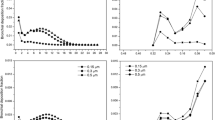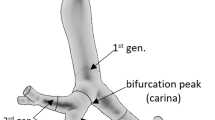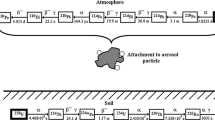Abstract
Biological response of exposure to radon progeny has long been investigated, but there are only few studies in which absorbed doses in lungs of laboratory animals were estimated. The present study is the first attempt to calculate the doses of inhaled radon progeny for mice. For reference, the doses for rats and humans were also computed with the corresponding models. Lung deposition of particles, their clearance, and energy deposition of alpha particles to sensitive tissues were systematically simulated. Absorbed doses to trachea and bronchi, bronchioles and terminal bronchioles, alveolar-interstitial regions, and whole lung were first provided as a function of monodisperse radon progeny particles with an equilibrium equivalent radon concentration of 1 Bq m−3 (equilibrium factor, 0.4 and unattached fraction, 0.01). Based on the results, absorbed doses were then calculated for (1) a reference mine condition and (2) a condition previously used for animal experiments. It was found that the whole lung doses for mice, rats, and humans were 34.8, 20.7, and 10.7 nGy (Bq m−3)−1 h−1 for the mine condition, respectively, while they were 16.9, 9.9, and 6.5 nGy (Bq m−3)−1 h−1 for the animal experimental condition. In both cases, the values for mice are about 2 times higher than those for rats, and about 3 times higher than those for humans. Comparison of our data on rats and humans with those published in the literature shows an acceptable agreement, suggesting the validity of the present modeling for mice. In the future, a more sophisticated dosimetric study of inhaled radon progeny in mice would be desirable to demonstrate how anatomical, physiological, and environmental parameters can influence absorbed doses.






Similar content being viewed by others
References
American Conference of Governmental Industrial Hygienists (ACGIH) (1985) Particle size-selective sampling in the workplace. Report of the ACGIH Technical Committee on Air Sampling Procedures, Cincinnati
Asgharian B, Hofmann W, Miller FJ (2001) Mucociliary clearance of insoluble particles from the tracheobronchial airways of the human lung. J Aerosol Sci 32:817–832
Beeckmans JM (1965) The deposition of aerosols in the respiratory tract. I. Mathematical analysis and comparison with experimental data. Can J Physiol Pharmacol 43:157–172
Birchall A, James AC (1994) Uncertainty analysis of the effective dose per unit exposure from radon progeny and implications for ICRP risk-weighting factors. Radiat Protect Dosim 53:133–140
Cheng YS, Hansen GK, Su YF, Yeh HC, Morgan KT (1990) Deposition of ultrafine aerosols in rat nasal molds. Toxicol Appl Pharmacol 106:222–233
Cross FT (1988) Radon inhalation studies in animals. Radiat Protect Dosim 24:463–466
Deetjen P (1997) Epidemiology and biological effects of radon. In: Pratzel HG, Deetjen P (eds) Radon in der Kur Medizin. ISMH Verlag, Geretsried
Desrosiers A, Kenedy A, Little JB (1978) 222Rn daughter dosimetry in the Syrian golden hamster lung. Health Phys 35:607–623
Fakir H, Hofmann W, Caswell R (2008) Radon progeny microdosimetry in human and rat bronchial airways: the effect of crossfire from the alveolar region. Radiat Protect Dosim 130:149–161
Felicetti SA, Wolff RK, Muggenburg BA (1981) Comparison of tracheal mucous transport in rats, guinea pigs, rabbits, and dogs. J Appl Physiol 51:1612–1617
Guyton AC (1947) Measurement of the respiratory volumes of laboratory animals. Am J Physiol 150:70–77
Harley NH (1988) Radon daughter dosimetry in the rat tracheobronchial tree. Radiat Protect Dosim 24:457–461
Harley NH, Meyers OA, Robbins ES (1992) 222Rn dosimetry in the dog lung. Radiat Protect Dosim 45:611–618
Harley NH, Cohen BS, Robbins ES (1996) The variability in radon decay product bronchial dose. Environ Int 22:S959–964
Hofmann W (2012) Modelling inhaled particle deposition in the human lung—a review. J Aerosol Sci 42:693–724
Hofmann W, Winkler-Heil R (2011) Radon lung dosimetry models. Radiat Protect Dosim 145:206–212
Hofmann W, Ménache M, Graham RC (1993) Radon progeny dosimetry in the rat lung. Health Phys 64:279–290
Ingham DB (1975) Diffusion of aerosols from stream flowing through a cylindrical tube. Aerosol Sci 6:125–132
International Commission of Radiation Units and Measurements (ICRU) (1993) Stopping powers and ranges for protons and alpha particles. ICRU Report 49. ICRU, Bethesda
International Commission on Radiological Protection (ICRP) (1994) Human respiratory tract model for radiological protection. ICRP Publication 66. Ann ICRP 24
International Commission on Radiological Protection (ICRP) (2007) The 2007 recommendation of the international commission on radiological protection. ICRP Publication 103. Ann ICRP 37
Ishikawa T, Tokonami S, Yonehara H, Fukutsu K, Yamada Y (2001) Effects of activity size distribution on dose conversion factor for radon progeny. Jpn J Health Phys 36:329–338 (in Japanese with English abstract)
Ishimori Y, Mitsunobu F, Yamaoka K, Tanaka H, Kataoka T, Sakoda A (2011) Performance of the first Japanese large-scale facility for radon inhalation experiments with small animals. Radiat Protect Dosim 146:31–33
James AC, Birchall A, Akabani G (2004) Comparative dosimetry of BEIR VI revisited. Radiat Protect Dosim 108:3–26
Kataoka T, Sakoda A, Ishimori Y, Toyota T, Nishiyama Y, Tanaka H, Mitsunobu F, Yamaoka K (2011) Study of the response of superoxide dismutase in mouse organs to radon using a new large-scale facility for exposing small animals to radon. J Radiat Res 52:775–781
Landahl HD (1963) Particle removal by the respiratory system note on the removal of airborne particulates by the human respiratory tract with particular reference to the role of diffusion. Bull Math Biol 25:29–39
Marsh JW, Birchall A (2000) Sensitivity analysis of the weighted equivalent lung dose per unit exposure from radon progeny. Radiat Protect Dosim 87:167–178
Marsh JW, Birchall A, Butterweck G, Dorrian M-D, Huet C, Ortega X, Reineking A, Tymen G, Schuler Ch, Vargas A, Vezzu G, Wendt J (2002) Uncertainty analysis of the weighted equivalent lung dose per unit exposure to radon progeny in the home. Radiat Protect Dosim 102:229–248
Marsh JW, Harrison JD, Laurier D, Blanchardon E, Paquet F, Tirmarche M (2010) Dose conversion factors for radon: recent developments. Health Phys 99:511–516
Ménache MG, Miller FJ, Raabe OG (1995) Particle inhalability curves for humans and small laboratory animals. Ann Occup Hyg 39:317–328
Monchaux G, Morlier JP, Morin M, Chameaud J, Lafuma J, Masse R (1994) Carcinogenic and cocarcinogenic effects of radon and radon daughters in rats. Environ Health Perspect 102:64–73
Monchaux G, Morlier JP, Altmeyer S, Debroche M, Morin M (1999) Influence of exposure rate on lung cancer induction in rats exposed to radon progeny. Radiat Res 153:S137–140
National Council on Radiation Protection and Measurements (NCRP) (1997) Deposition, retention and dosimetry of inhaled radioactive substances. NCRP Report No. 125. NCRP, Bethesda
Nikezic D, Haque AKMM, Yu KN (2002) Absorbed dose delivered by alpha particles calculated in cylindrical geometry. J Environ Radioact 60:293–305
Oldham MJ, Robinson RJ (2007) Predicted tracheobronchial and pulmonary deposition in amurine asthma model. Anat Rec 290:1309–1314
Porstendörfer J (2001) Physical parameters and dose factors of the radon thoron decay products. Radiat Protect Dosim 94:365–373
Sakoda A, Ishimori Y, Kawabe A, Kataoka T, Hanamoto H, Yamaoka K (2010) Physiologically based pharmacokinetic modeling of inhaled radon to calculate absorbed doses in mice, rats, and humans. J Nucl Sci Technol 47:731–738
Schum M, Yeh HC (1980) Theoretical evaluation of aerosol deposition in anatomical models of mammalian lung airways. Bull Math Biol 42:1–15
United Nations Scientific Committee on the Effects of Atomic Radiation (UNSCEAR) (2000) Annex B. Exposure from natural radiation sources. UNSCEAR 2000 Report to the General Assembly, with Scientific Annexes. United Nations, New York
Wang CS (2005) Inhaled particles. Elsevier, London
Winkler-Heil R, Hofmann W, Marsh JW, Birchall A (2007) Comparison of radon lung dosimetry models for the estimation of dose uncertainties. Radiat Protect Dosim 127:27–30
Yamaoka K, Mitsunobu F, Hanamoto K, Shibuya K, Mori S, Tanizaki Y, Sugita K (2004) Biochemical comparison between radon effects and thermal effects on humans in radon hot spring therapy. J Radiat Res 45:83–88
Yeh HC (1974) Use of a heat transfer analogy for a mathematical model of respiratory tract deposition. Bull Math Biol 36:105–116
Yeh HC, Schum GM (1980) Models of human lung airways and their application to inhaled particle deposition. Bull Math Biol 42:461–480
Yeh HC, Schum GM, Duggan MT (1979) Anatomic models of tracheobronchial and pulmonary regions of the rat. Anat Rec 195:483–492
Yeh HC, Cuddihy RG, Phalen RF, Chang IY (1996) Comparisons of calculated respiratory tract deposition of particles based on the proposed NCRP models and the new ICRP model. Aerosol Sci Technol 25:134–140
Zhang L, Yu CP (1993) Empirical equations for nasal deposition of inhaled particles in small laboratory animals and humans. Aerosol Sci Technol 19:51–56
Author information
Authors and Affiliations
Corresponding author
Appendix
Appendix
Physiological parameters
- n i :
-
Number of airways in the ith generation
- L i :
-
Airway length in the ith generation (cm)
- D i :
-
Airway diameter in the ith generation (mm)
- R i :
-
Airway radius in the ith generation (cm)
- V i :
-
Airway volume in the ith generation (ml)
- θ i :
-
Branching angle in the ith generation (rad), describing the change in direction of the bulk airflow from the i − 1th generation into the ith generation
- ϕ i :
-
Gravity angle in the ith generation (rad), describing the inclination of the airway segment to gravity
- S i :
-
Total airway surface area in the ith generation (mm2)
- \( \bar{v}_{\text{i}} \) :
-
Mean flow velocity of inhaled or exhaled air in the ith generation (cm s−1)
- \( \bar{V} \) :
-
Mean volumetric flow rate of inhaled or exhaled air (ml s−1)
- TLC:
-
Total lung capacity (ml), corresponding to the air volume of the lungs at maximum inhalation
- TV:
-
Tidal volume (ml), corresponding to the air volume inhaled and exhaled during a breath
- LV:
-
Adjusted lung volume (ml)
- FRC:
-
Functional residual capacity (ml), corresponding to the air volume of the lungs at end-exhalation of a normal breath
- f :
-
Respiratory frequency (min−1)
- B :
-
Breathing rate (ml min−1)
- W :
-
Body mass (g)
Aerosol and exposure parameters
- d p :
-
Particle diameter (cm)
- r p :
-
Particle radius (cm)
- ρ p :
-
Particle density (kg cm−3)
- D p :
-
Particle diffusion coefficient in air (cm2 s−1)
- g :
-
Gravitational acceleration (cm s−2)
- C :
-
Cunningham slip correction factor
- μ :
-
Viscosity of air (kg cm−1 s−1)
- Kn :
-
Knudsen number
- λ p :
-
Mean free path of particles in air (cm)
- Stk :
-
Stokes number
- N n :
-
Number of particles per ambient air volume (cm−3); the subscript, n, stands for a radionuclide
- λ n :
-
Decay constant (min−1); the subscript, n, stands for a radionuclide
- C Rn :
-
Equilibrium equivalent radon concentration in ambient air (Bq m−3)
- F :
-
Equilibrium factor
- f p :
-
Unattached fraction, corresponding to the fraction of the potential alpha energy concentration of short-lived radon progeny that is not attached to ambient aerosols
- GM:
-
Geometric mean particle size (nm)
- GSD:
-
Geometric standard deviation
- AMAD:
-
Activity median aerodynamic diameter (nm)
Deposition
- η I :
-
Inhalability
- η ET,In :
-
Deposition efficiency of the ET region at an inhalation phase
- η ET,Ex :
-
Deposition efficiency of the ET region at an exhalation phase
- η i,In :
-
Deposition efficiency of the ith generation at an inhalation phase
- η i,Ex :
-
Deposition efficiency of the ith generation at an exhalation phase
- η i :
-
Deposition efficiency of the ith generation at an inhalation or exhalation phase
- η i,D :
-
Deposition efficiency of the ith generation by diffusion
- \( \eta_{\text{i, D}}^{\text{E}} \) :
-
Deposition efficiency of the ith generation by diffusion; this considers the effect of entrance configuration
- η i,S :
-
Deposition efficiency of the ith generation by sedimentation
- η i,I :
-
Deposition efficiency of the ith generation by internal impaction
- DE i,In :
-
Deposition fraction in the ith generation at an inhalation phase
- DE i,Ex :
-
Deposition fraction in the ith generation at an exhalation phase
- DE i :
-
Deposition fraction in the ith generation per breath, corresponding to the fraction of the number or activity of particles of a given size that are present in a volume of ambient air before inhalation
- DE i,n :
-
Deposition fraction in the ith generation per breath; the subscript, n, stands for a radionuclide
Clearance
- \( \bar{T}_{\text{i}} \) :
-
Mean residence time (min), corresponding to the time required for mucous clearance of particles from the ith generation to the i − 1th
- v i :
-
Mucous velocity in the ith generation (mm min−1)
- M i,n :
-
Number of particles deposited in the ith generation; the subscript, n, stands for a radionuclide
Dosimetry
- A i :
-
Radioactivity in the ith generation (Bq)
- E α :
-
Energy of alpha particles (MeV)
- m T :
-
Mass of the target tissue (kg)
- D R :
-
Absorbed dose in the region R of the lung (Gy)
Rights and permissions
About this article
Cite this article
Sakoda, A., Ishimori, Y., Fukao, K. et al. Lung dosimetry of inhaled radon progeny in mice. Radiat Environ Biophys 51, 425–442 (2012). https://doi.org/10.1007/s00411-012-0431-z
Received:
Accepted:
Published:
Issue Date:
DOI: https://doi.org/10.1007/s00411-012-0431-z




